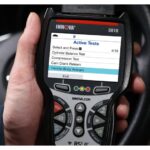The transition from OBD1 to OBD2 diagnostic systems in the mid-1990s often causes confusion, especially for owners of 1994 and 1995 vehicles. This article clarifies the differences between OBD1 and OBD2 connectors and explains how to connect to a vehicle equipped with an OBD1 system using a 16-pin OBD2 style connector.
OBD1 Systems in 1994-1995 Vehicles
While 1996 and later models generally adopted the standardized OBD2 system, many 1994 and 1995 vehicles retained OBD1 systems despite having a 16-pin connector that resembles the OBD2 connector. This is particularly common in certain GM models, including Camaros, Firebirds, Corvettes, and LT1-equipped cars, as well as some Australian Holden and Commodore vehicles. These vehicles use a 16-pin connector for convenience, utilizing pins 16 for +12v power, pin 5 for ground, and pin 9 for 8192 baud serial data communication. This setup allows for easier access for diagnostic tools.
Using an OBD1 Cable with a 16-Pin Connector
To connect to these OBD1 systems with a 16-pin connector, a specialized OBD1 cable with a matching 16-pin OBD2 style connector is required. This cable allows direct connection to the vehicle’s ECM/PCM (Engine Control Module/Powertrain Control Module) for data retrieval and diagnostics. It’s crucial to confirm the presence of the 16-pin connector under the dash before ordering this type of cable. Other OBD1 systems utilize a different connector style, typically a 12-pin connector.
OBD1 and OBD2: Key Distinctions
The core difference lies in the standardization of OBD2. OBD2 introduced a universal connector and communication protocol, enabling consistent diagnostics across various vehicle makes and models. OBD1, on the other hand, lacked this standardization, with different manufacturers employing unique protocols and connector types.
Instrument Cluster Programming and Other Applications
Beyond basic diagnostics, the 16-pin OBD1 cable with an OBD2 style connector can also be used for instrument cluster programming in certain vehicles. For instance, the 2004-2006 Pontiac GTO allows for modifications to features like shift light activation, cluster logo, and shutdown text using this cable and specific software. Similar functionalities might exist in other GM vehicles of that era.
Choosing the Right Cable for Your Vehicle
For 1994-1995 vehicles with the 16-pin connector, the OBD1 cable with the matching connector provides a convenient solution. However, for vehicles with the 12-pin OBD1 connector, a different cable or adapter is necessary. If compatibility across various OBD1 systems is a priority, a bare pin cable offering broader compatibility might be a better option. For 1996 and later OBD2 vehicles, a dedicated OBD2 scan tool is required for powertrain sensor scanning and code reading.

